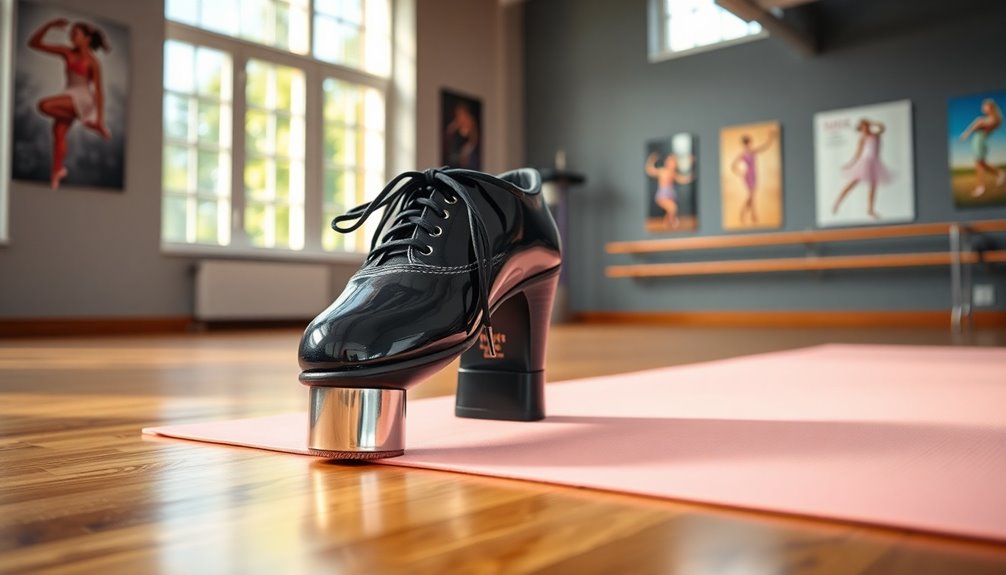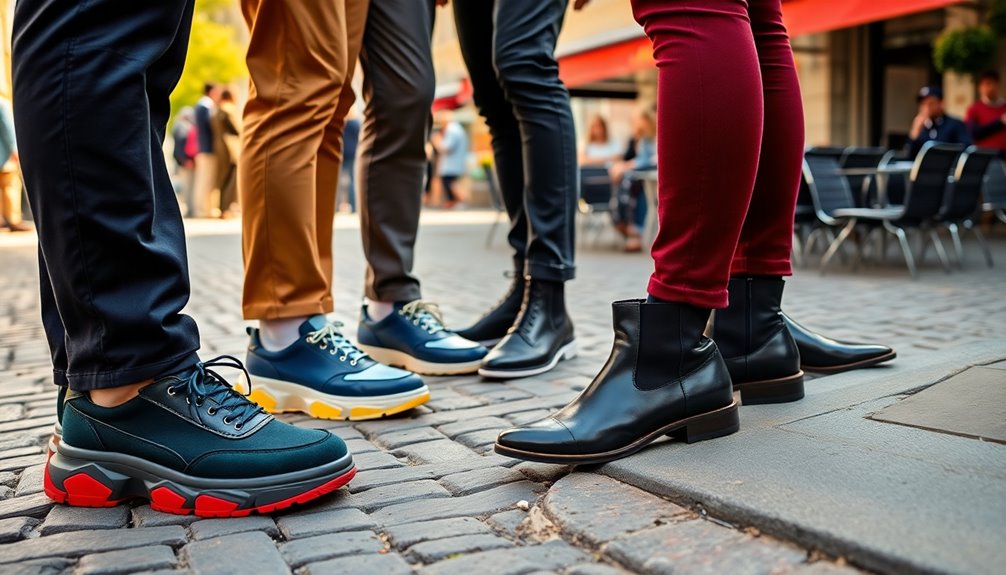Choosing the best tap shoes as a beginner sets a solid foundation for your dance journey. Opt for full sole designs for greater stability and support while mastering your basics. Leather is ideal for durability and sound quality, but synthetic options offer a lightweight, budget-friendly choice. Look for Oxfords to ensure comfort and ankle support, keeping heel height low to enhance control. Brands like Capezio and Bloch are reliable for quality without breaking the bank. With the right shoes, you'll groove with confidence, and there's plenty more to discover about enhancing your tap skills ahead.
Key Takeaways
- Opt for Oxford Style tap shoes for beginners; they provide excellent ankle support and a stable, flat sole for easy movement.
- Choose full sole shoes for added stability and support, which helps beginners focus on mastering basic tap techniques.
- Select leather materials for durability and a warm sound; they withstand rigorous practice and enhance overall dance experience.
- Start with low heel shoes to promote comfort and control, reducing the risk of ankle strain during learning.
- Consider budget-friendly options from brands like Capezio and Dancewear Solutions that offer reliable quality for beginners starting their dance journey.
Understanding Tap Shoe Styles
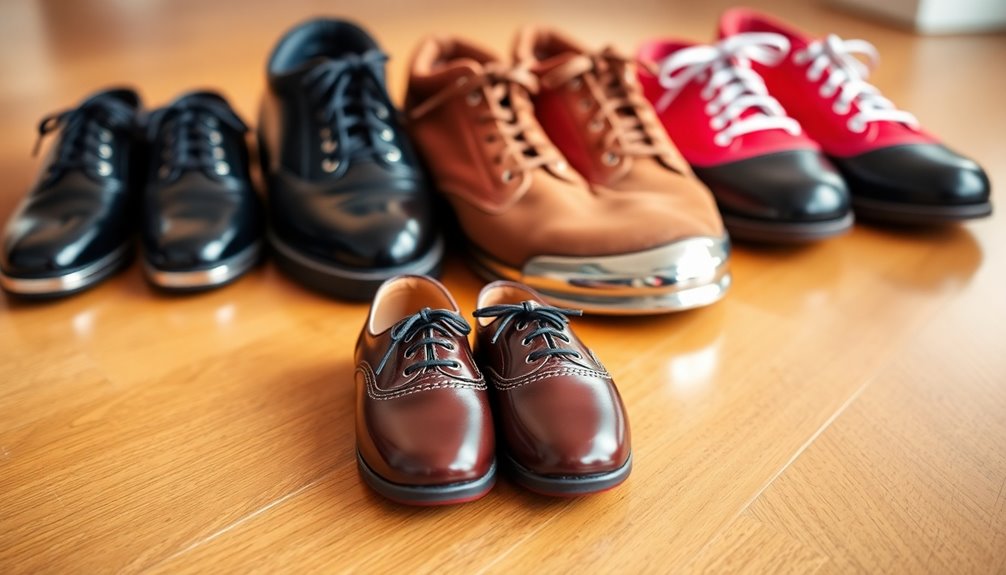
When you're stepping into the world of tap dancing, understanding the different tap shoe styles can really help you find the perfect pair.
The Oxford style tap shoes are a classic choice, featuring a low, lace-up design that offers excellent ankle support. Their flat sole and small heel make them versatile for both beginners and experienced dancers, ensuring long-lasting comfort.
If you're looking for something with a bit more elegance, consider Mary-Jane style tap shoes. They've a strap across the instep, providing a secure fit while allowing for easy adjustments. The elevated heel encourages smooth pivoting and is favored by advanced dancers for intricate footwork.
Jazz style tap shoes combine features of classic jazz shoes with tap plates, allowing for fluid movements. They're lightweight and designed for nuanced sound, making them a popular choice among professionals.
Lastly, flex style tap shoes feature a split sole construction that enhances flexibility and articulation, providing a balance of style and performance.
Each style serves different needs, so choose one that aligns with your tap dancing goals and comfort preferences.
Choosing the Right Materials

Selecting the right materials for your tap shoes can significantly impact your dancing experience.
Leather is a popular choice due to its durability and natural breathability, which keeps your feet cool during intense sessions. It can withstand rigorous practice and last for years, making it a worthwhile investment. However, leather requires regular maintenance, including cleaning and conditioning, which can be a consideration for some. Additionally, the role of tap shoes in producing distinctive sounds is vital for a fulfilling tap dance experience.
If you're looking for something lightweight and waterproof, synthetic materials might be your best bet. They're generally easier to clean and maintain, but keep in mind they may not provide the same breathability as leather, leading to sweaty feet.
Canvas offers a balance, being more breathable than synthetic options but less so than leather.
Sound quality is also crucial; leather produces a warm, resonant tap sound that many dancers prefer. Synthetic shoes may not deliver the same richness in sound.
Ultimately, your choice should reflect your personal preferences, budget, and commitment to maintenance. By understanding the pros and cons of each material, you can make an informed decision that enhances your tap dancing journey.
Exploring Sole Types
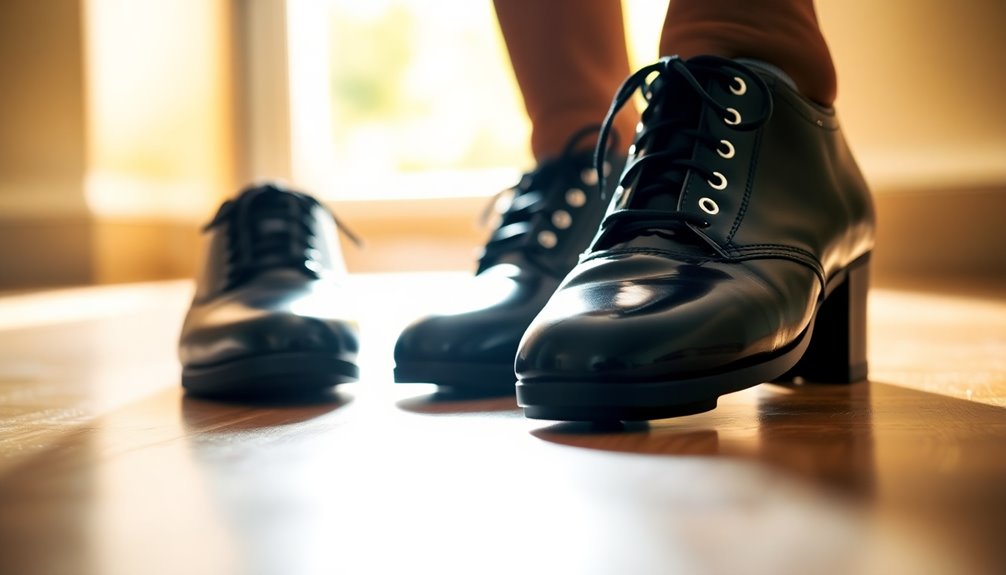
Understanding the different sole types in tap shoes is essential for beginners aiming to enhance their dancing skills. There are primarily two types of soles: full sole and split sole, each serving unique purposes.
Full sole tap shoes have a continuous base material underneath, providing excellent foot and ankle support. They're heavier and more rigid, which gives you extra stability as you learn. This makes them ideal for beginners who want to explore powerful and loud tap styles. Full sole shoes are known for their ability to offer continuous support for dancers.
With full sole shoes, you'll feel secure in your steps, allowing you to focus on mastering basic techniques.
On the other hand, split sole tap shoes feature a gap under the arch, offering increased flexibility. While they allow for fluid movements and intricate footwork, they're not recommended for beginners.
You'll need a certain amount of foot strength to use them effectively, making them better suited for advanced dancers who enjoy nuanced sound production and more mobility.
Tap Plate Attachments Explained
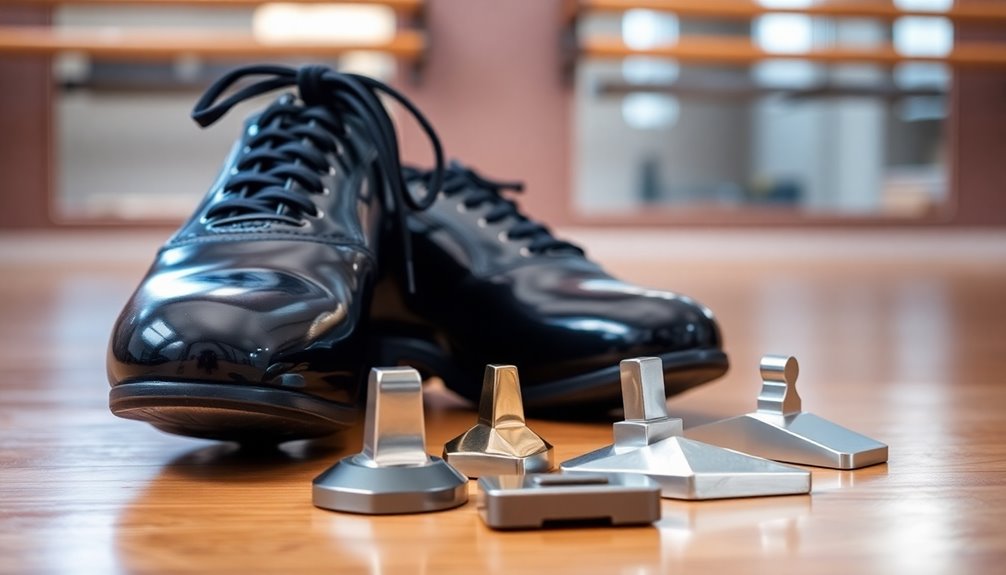
Tap plate attachments play a crucial role in enhancing your tap dancing experience, so knowing your options is essential. You'll primarily encounter two types of materials: self-adhesive plastic sheets and non-adhesive plastic sheets that require glue application.
While self-adhesive plates can be easier to install, they might cause a loss in volume and clarity during your performance. On the other hand, non-adhesive plates, although requiring more effort to attach, preserve the sound quality and maintain your dance's integrity. Additionally, the choice of specific adhesive can significantly impact both installation ease and the longevity of your tap plates.
When installing self-adhesive plates, it's vital to use tape and a water solution to help position them correctly. This method allows you to manipulate the attachment, but be aware that incorrect placement can lead to frustrating issues.
For non-adhesive plates, you'll need a specific glue and careful handling to avoid air bubbles or misalignment.
Ultimately, the goal is to ensure your tap plates are securely attached and correctly positioned. This attention to detail will help you achieve the best sound and performance.
Importance of Heel Height

Finding the right heel height in your tap shoes is essential for your comfort and performance as a beginner. Low heel tap shoes are often the best choice because they provide more stability and ease of movement. This reduced height lessens the risk of ankle strain, allowing you to focus on mastering your tap steps with better control. Additionally, the specific design of low heel shoes contributes to the overall rhythm and style of your dance.
Plus, they're generally more comfortable and easier to dance in, making them perfect for beginners.
While high heel tap shoes can enhance the elegance of your appearance and produce a louder sound, they can be challenging to adjust to at first. As a beginner, you might find that high heels alter your weight placement and require adjustments in your technique.
Although they can offer better support for advanced dancers, starting with a lower heel can help you develop your skills without the added difficulty.
Budget and Brand Options
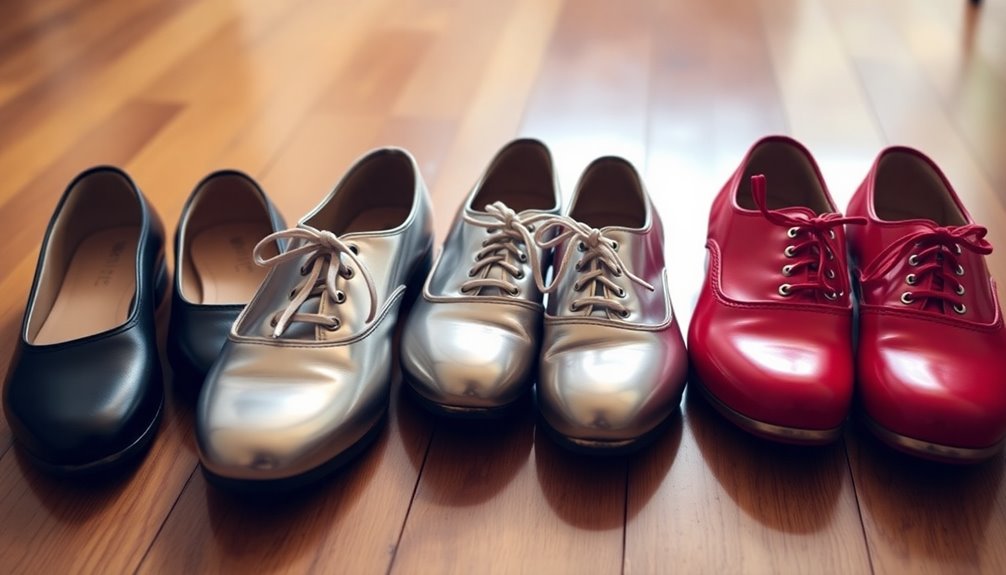
When it comes to selecting budget-friendly tap shoes, you'll discover a variety of options that cater to beginners without breaking the bank. You can find low-cost shoes starting around $40, which offer solid quality with essential features like quality cast taps and moisture-wicking linings. Brands like Capezio's Tic-Tac-Toe and Dancewear Solutions' Beginner Tap Shoe B60 are excellent choices in this range. Choosing the right tap shoes is crucial for enhancing your comfort and performance as you begin your dance journey.
If you're willing to spend a bit more, mid-range options priced between $70 and $100 provide real leather construction and enhanced comfort features. Consider Capezio's Cadence shoe or Bloch's Tap-On Tap Shoe for a balance of quality and affordability.
When exploring brands, Capezio and Bloch stand out for their reliable choices, while Roch Valley and Dance Class offer great affordability without sacrificing quality.
Look for features like secure closures, full-sole designs for stability, and cushioned padding for added comfort.
Ultimately, the right tap shoe will support your learning journey while fitting your budget, so take the time to explore these options and find the perfect pair to start your dance adventure.
Frequently Asked Questions
How Do I Determine My Correct Tap Shoe Size?
To determine your correct tap shoe size, start by measuring your foot using a Brannock device.
Make sure your toes are flat and your socks are snug.
Compare the heel-to-toe length and arch length, using the larger measurement.
Refer to Bloch's size charts for conversions between US, UK, and EUR sizes.
Opt for a snug fit, but avoid shoes that cause pain or discomfort.
Can I Wear My Tap Shoes Outside?
You shouldn't wear your tap shoes outside. The soft metal plates can get scratched, affecting their sound quality and your performance.
Outdoor surfaces can also damage the materials, causing splits or premature wear. Moisture and rough conditions can lead to water damage and deterioration.
To keep your tap shoes in top shape, stick to indoor use, clean them after every class, and regularly check for any signs of wear or damage.
How Often Should I Replace My Tap Shoes?
You should replace your tap shoes based on usage and condition. If you dance daily, expect to replace them every 6-12 months.
For recreational dancers, a pair can last several years. Keep an eye out for loose taps, worn soles, or any discomfort, as these are signs it's time for a new pair.
Regular maintenance, like cleaning and proper storage, can help extend their lifespan.
What Type of Socks Should I Wear With Tap Shoes?
When you're wearing tap shoes, it's best to choose low cut or no show socks. They keep your feet dry and won't peek out of your shoes.
Look for moisture-wicking materials like nylon or cotton blends to prevent blisters and enhance comfort.
If you need extra support, consider crew style socks with arch support. This way, you'll stay comfortable and stable while you dance, allowing you to focus on your performance.
Are There Any Specific Care Instructions for Tap Shoes?
Yes, there are specific care instructions for tap shoes.
You should regularly clean them with a damp cloth and use leather cleaners for deeper cleaning. Keep them dry and avoid water to prevent stretching.
Air them out after use to combat moisture and odor. Check the taps and soles for wear, tightening screws as needed.
Lastly, consider using protective insoles to manage sweat and keep your shoes fresh.
Conclusion
Starting your tap dance journey means picking the right shoes, and you've got the tools to make an informed choice. Remember to consider the style, materials, sole types, and heel height that suit your needs. Don't forget to explore different brands and budget options that align with your goals. With the right pair of tap shoes, you'll hit the floor with confidence, ready to express yourself through dance. So lace up and let the rhythm guide you!
